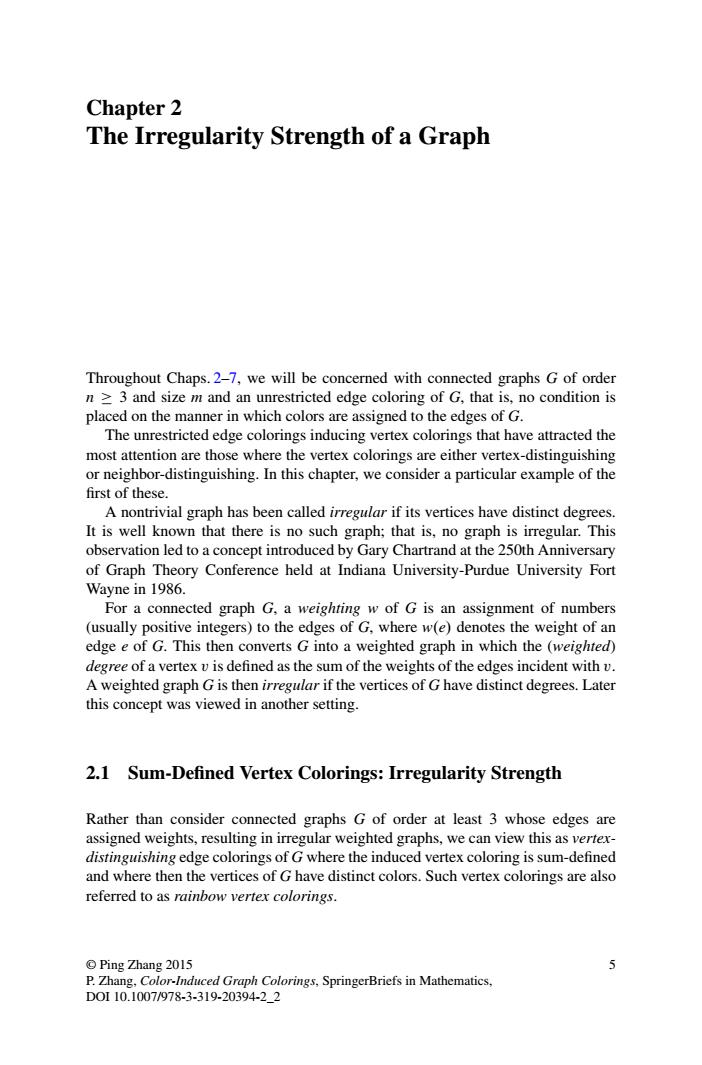正在加载图片...

Chapter 2 The Irregularity Strength of a Graph Throughout Chaps.2-7,we will be concerned with connected graphs G of order 3 and size m and an unrestricted edge coloring of G.that is,no condition is in which c olors re assigned to the edge s of G. The edge colorings inducing vertex colorings that have attracted the most attention are those where the vertex colorings are either vertex-distinguishing or neighbor-distinguishing.In this chapter,we consider a particular example of the first of these. A nontrivial graph has been called irregular if its vertices have distinct degrees It is well known that there is no such graph;that is,no graph is irregular.This observation led to a concept introduced by Gary Chartrand at the 250th Anniversary of Graph Theory Conference held at Indiana University-Purdue University For Way 86 ected graph G.a weighring w of G is an assignm ent of number (usually positive integers)to the edges of G.where w(e)denotes the weight of a edge e of G.This then converts G into a weighted graph in which the (weighted) degree of a vertex v is defined as the sum of the weights of the edges incident with v. A weighted graph G is then irregular if the vertices of G have distinct degrees.Later this concept was viewed in another setting. 2.1 Sum-Defined Vertex Colorings:Irregularity Strength Rather than consider connected graphs G of order at least 3 whose edges are assigned weights,resulting in irregular weighted graphs,we can view this as vertex- distinguishing edge colorings of G where the induced vertex coloring is sum-defined and where then the vertices of G have distinct colors.Such vertex colorings are also referred to as rainbow vertex colorings. Ping Zhang 2015 lorings.SpringerBriefs in Mathematics.Chapter 2 The Irregularity Strength of a Graph Throughout Chaps. 2–7, we will be concerned with connected graphs G of order n 3 and size m and an unrestricted edge coloring of G, that is, no condition is placed on the manner in which colors are assigned to the edges of G. The unrestricted edge colorings inducing vertex colorings that have attracted the most attention are those where the vertex colorings are either vertex-distinguishing or neighbor-distinguishing. In this chapter, we consider a particular example of the first of these. A nontrivial graph has been called irregular if its vertices have distinct degrees. It is well known that there is no such graph; that is, no graph is irregular. This observation led to a concept introduced by Gary Chartrand at the 250th Anniversary of Graph Theory Conference held at Indiana University-Purdue University Fort Wayne in 1986. For a connected graph G, a weighting w of G is an assignment of numbers (usually positive integers) to the edges of G, where w.e/ denotes the weight of an edge e of G. This then converts G into a weighted graph in which the (weighted) degree of a vertex v is defined as the sum of the weights of the edges incident with v. A weighted graph G is then irregular if the vertices of G have distinct degrees. Later this concept was viewed in another setting. 2.1 Sum-Defined Vertex Colorings: Irregularity Strength Rather than consider connected graphs G of order at least 3 whose edges are assigned weights, resulting in irregular weighted graphs, we can view this as vertexdistinguishing edge colorings of G where the induced vertex coloring is sum-defined and where then the vertices of G have distinct colors. Such vertex colorings are also referred to as rainbow vertex colorings. © Ping Zhang 2015 P. Zhang, Color-Induced Graph Colorings, SpringerBriefs in Mathematics, DOI 10.1007/978-3-319-20394-2_2 5�